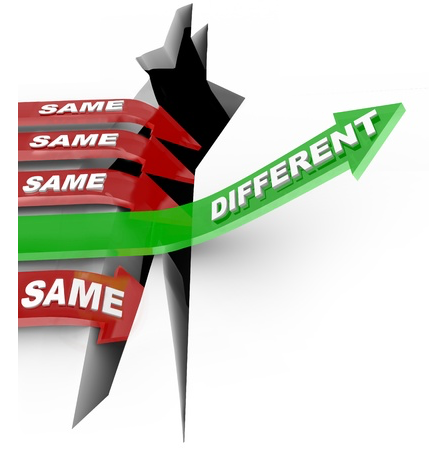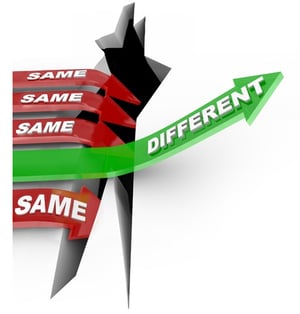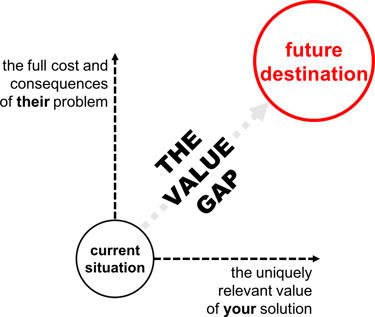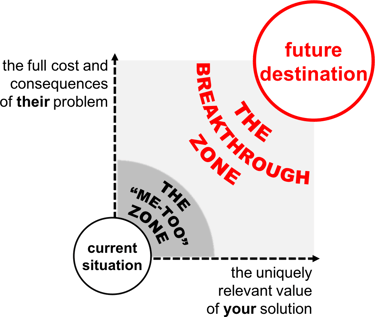Are you selling "me-too" or "breakthrough"?
February 1, 2018

 Have you ever wondered why so many apparently promising B2B sales opportunities end with the prospect deciding to either stick with the status quo or choose the cheapest from a set of apparently similar options? Or why even if they do have a preference, the customer is often only willing to pay a very modest premium for what they see as no more than a "slightly better" solution?
Have you ever wondered why so many apparently promising B2B sales opportunities end with the prospect deciding to either stick with the status quo or choose the cheapest from a set of apparently similar options? Or why even if they do have a preference, the customer is often only willing to pay a very modest premium for what they see as no more than a "slightly better" solution?
This is essentially a problem of differentiation - or the lack of it. When every vendor appears to be addressing apparently similar needs with apparently similar solutions, it's no wonder that prospective customers behave in a confused or risk-averse way.
Adopting a more professional sales approach can help a little - it can potentially increase your win rates and sometimes it can help you earn relatively modest additional margins.
But if that's not enough for you - if you expect your sales organisation to do much better than that - you've got to take the discovery process far beyond what your prospective customer thinks they may currently need and equip your sales people to systematically uncover unrecognised or undervalued problems or opportunities that your solution is uniquely capable of addressing.
We call this approach "selling in the breakthrough zone" and it starts by establishing the widest possible value gap by contrasting (1) your prospect’s current situation and the future destination they need to reach and (2) the common features they can expect from any alternative solution and the unique capabilities that only your organisation can credibly claim to deliver.
ESTABLISHING THE VALUE GAP
 When contrasting the value gap between our prospect's current situation and their future destination, we need to help our customers to recognise all of the uncomfortable costs, consequences and implications of sticking with the status quo. We need to encourage them to acknowledge that the longer they continue on their current trajectory the less likely it is that they will achieve their critical future objectives.
When contrasting the value gap between our prospect's current situation and their future destination, we need to help our customers to recognise all of the uncomfortable costs, consequences and implications of sticking with the status quo. We need to encourage them to acknowledge that the longer they continue on their current trajectory the less likely it is that they will achieve their critical future objectives.
We need to elevate their current pain, as well as amplifying their future gain. Decision makers are twice as likely to spend money on eliminating a current problem than they are to invest in the potential of a future upside.
There is solid science behind this: Daniel Kahneman, the Nobel Prize winning behavioural economist identified both the "status quo bias" and the "loss aversion effect" as having a significant and pervasive influence on organisational buying decisions.
And having helped the prospect to recognise and acknowledge the full costs, consequences and implications of the problems and opportunities they are faced with and the risks associated with ignoring them, we then need to stretch the other value axis and show how our unique capabilities can drive far better outcomes compared with all the other options they are likely to be considering.
AVOIDING THE VENEER OF "ADDED VALUE"
We have no chance of achieving this if we focus on the same topics, use the same language and buzz words and project similar results as our competitors. And even adopting a veneer of "added value" is still likely to leave us firmly anchored in the "me-too" zone. When customers see all their options as being broadly similar, they either tend to do nothing or to choose the cheapest option.
 It’s only through establishing the uniquely relevant value of our offering that we can create clear and compelling differentiation between our approach and that of all the other options our prospect is likely to be considering. And of course, when customers see little meaningful differentiation they are unlikely to be prepared to pay any significant premium for our or any other solution.
It’s only through establishing the uniquely relevant value of our offering that we can create clear and compelling differentiation between our approach and that of all the other options our prospect is likely to be considering. And of course, when customers see little meaningful differentiation they are unlikely to be prepared to pay any significant premium for our or any other solution.
The consequences of selling in the "me-too" zone instead of the "breakthrough zone" are painful: close dates and win probabilities tend to be unpredictable, sales cycles tend to be longer than they could be, win rates tend to be lower than they should be, and the discounts we have to give away tend to be higher than they have any reason to be.
And let’s recognise that slapping a little value-added lipstick on what is fundamentally still a commodity pig is unlikely to fool many of our customers, or to materially increase our chances of winning their business at a higher margin.
STRETCHING THE VALUE GAP BOTH WAYS
By the way, capturing and characterising the value gap is one of the key elements of our Value Selling System® Powered by Membrain - our fresh perspective on transforming CRM from merely a sales administration tool into an highly effective and performance-enhancing sales support system for complex B2B sales environments. You can check it out here.
It’s only by stretching our prospective customer’s value gap as far as it can go in both directions - both the full impact of the problem and the unique value of our solution - that we give ourselves the opportunity to create, capture and confirm our unique value to our customers and maximise the profitable return we can legitimately earn from our efforts.
So what has led me to the opinion that this happens far less often than it ought to? Here are some of the most common reasons - you may have others:
- Our sales people lack the knowledge, confidence or skill to have meaningful conversations about the true cost, consequences and implications of our prospective customer’s problems
- Our sales people are so desperate to move the sale forwards that they fail to complete a proper in-depth discovery process before rushing to propose a solution
- Our sales people lack the detailed knowledge necessary to differentiate our solution from their prospect’s other options in a way that is meaningful to their audience
- We are competing in a commodity market that is fundamentally undifferentiable, so all we can hope to do is to sell on price and availability - and that means being the cheapest
If you agreed with the last reason, then you’re probably not really the audience I was writing this blog for, but if you’re in a complex B2B sales environment then let’s all agree that the first three reasons, whilst occasionally understandable are surely never either excusable or acceptable.
So - how can you help your sales people to establish the widest possible value gap in their conversations with their prospective customers? And if they are not already doing this, how many winnable deals might they be losing, and how much profit might they be giving away in the deals they do end up winning? It's a sobering thought, isn't it?
IF YOU LIKED THIS, YOU'LL PROBABLY ALSO APPRECIATE:
BLOG: Situational awareness - a critical factor in B2B sales
BLOG: Decoding your prospect's buying decision mode
BLOG: Self-awareness and self-honesty in complex B2B sales
BLOG: We need to collectively develop sales competencies
BLOG: Where is your prospect in their buying journey?
WEBINAR: Selling in the Breakthrough Zone
DOWNLOAD: Our Guide to the Value Selling System
DOWNLOAD: 12-Point Value Selling Self-Assessment
ABOUT THE AUTHOR
 Bob Apollo is a Fellow of the Association of Professional Sales and the founder of UK-based Inflexion-Point Strategy Partners, home of the Value Selling System®. Following a successful career spanning start-ups, scale-ups and corporates, Bob now works with a growing client base of tech-based B2B-focused high-growth businesses, enabling them to progressively create, capture and confirm their unique value in every customer interaction.
Bob Apollo is a Fellow of the Association of Professional Sales and the founder of UK-based Inflexion-Point Strategy Partners, home of the Value Selling System®. Following a successful career spanning start-ups, scale-ups and corporates, Bob now works with a growing client base of tech-based B2B-focused high-growth businesses, enabling them to progressively create, capture and confirm their unique value in every customer interaction.


Comments